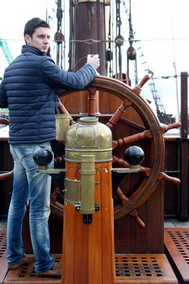Discovery visit – a view of past Antarctic exploration
Here’s the first activity report from the Antarctic explorers of 2016:
The day after completing a challenging first semester, the Antarctica group celebrated by visiting the Discovery Centre in blustery Dundee, a museum housing the RRS Discovery. We were met by Brian Kelly, who awed us with tales of the ship. Though Dundee was known for whaling ships, the Discovery was the first vessel constructed for scientific research, and sailed to Antarctica in 1901 to explore the continent under the watchful eye of Captain Robert Falcon Scott. We were all very impressed by the tall masts but not so keen on the idea of the side busts dipping into the water in rough seas. A few of the group with a head for heights thought the crow’s nest would be an excellent point for our sea surveys.
The immense food stores with many common household names were inspected closely. Fancy Coleman’s mustard? The sailors certainly did. How about Mexican chocolate? Well, if on board, you would have had access to 2500 kg of it. Though liquor was closely guarded, the sailors did receive a daily rum ration, a concept that some members of the group want to replicate on our journey.
When below decks we were fascinated by the thickness of the hull, strongly reinforced to resist the pressure of the ice forming around the ship. As the last traditional three-masted wooden ship to be built in Britain, the Discovery was made up of several different species with varying densities and strengths. While pine and oak were used for the hull, the floors throughout the ship were made of teak, and mahogany certainly made an appearance in the Officers’ Ward.
While the 11 officers slept in comfort and privacy, the 37 crew members lived a less glamorous life. Though cramped, the hammocks seemed a good idea for sleeping in rough seas, lowering the risk of falling out. Despite this boon, everyone felt they would be quite at home in the officer’s cabins instead.
After exploring aboard the ship, we toured the rest of the museum, which houses tons of artefacts from throughout the Discovery’s history. Some of the more notable items included the plates and cups stamped with the royal emblem, and the harmonium used for the evening entertainment.
Though the Discovery is steeped in incredible history, it was a great relief to know that our trip to the Antarctic will be aboard a slightly more luxurious vessel in warmer temperatures, and that we won’t have to spend hours shovelling coal to fuel the trip. Finally, it was back to St Andrews to say goodbye to the EMMS students who leave for Oban next semester, and to travel home for the holidays.
Text: Laine Brice and Clare Watkins, Pictures: Clair Evers
